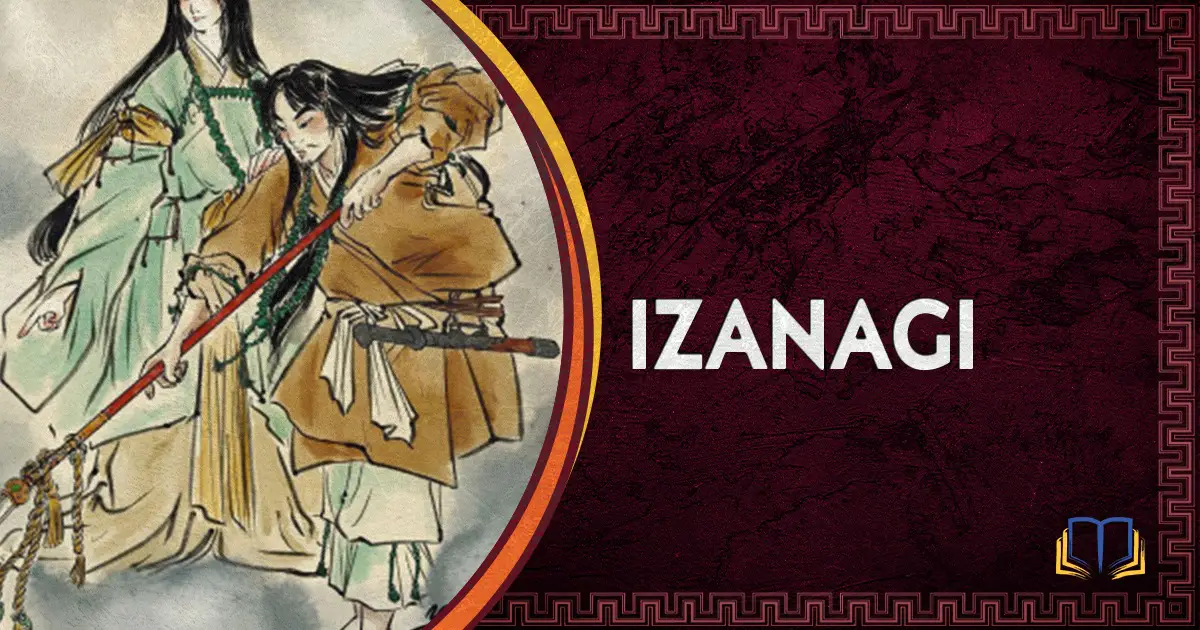Izanagi is a Japanese deity in the Shinto religion. Along with his sister-wife Izanami, he’s credited with creating the islands of Japan and for conceiving many kami, which are spirits or “holy powers.” He and Izanami are of the seventh and last generation of primordial deities that came into existence following the formation of heaven and earth.
Origins
Izanagi’s origins come to us from two different ancient Japanese texts. The first, circa 712 AD, is called the Kojiki. This text is a recording of myths, legends, historical accounts, genealogies, and oral traditions, among other things. In the Kojiki, Izanagi is written as Izanagi-no-Kami and Izanagi-no-Mikoto. In a later, more detailed text, titled Nihon Shoki, his name is also written as Izanagi-no-Mikoto.
These two texts, the Kojiki and the Nihon Shoki, provide the basis for Japanese mythology and many aspects of them were later incorporated into Shinto religious practices.
Family
Izanagi, along with his twin sister Izanami, form the last of seven generations of deities, also known as kami, after the birth of heaven and earth. According to the Kojiki, these seven generations only came into being after the Kotoamatsukami, which were the gods that were there at the birth of the universe.
The first two generations were said to have been born alone, as opposed to later generations of kami that were born in male-female pairs. The last pair to be born was that of Izanagi and Izanami, who were “conceived” by Omodaru and Kashiko-ne. Izangi and Izanami were then tasked with creating the islands of Japan, and also created the many Japanese deities, including the storm god Susanoo, the thunder god Raijin, the sun goddess Amaterasu, and many more.
Appearance
In Japanese art, Izanagi appears as a man, sometimes depicted with a black beard and/or mustache, and other times depicted with no facial hair. He usually has long black hair and is seen wearing white or tan robes. He’s almost always depicted with his wife/sister Izanami. The pair are often seen standing on a bridge in the sky or the “Bridge of Heaven,” reaching down to stir the ocean with the spear Ame-no-nuboko.
Izanagi Myths
Let’s take a look at the mythology surrounding Izanagi to get a better idea of his role in the Shinto religion and Japanese mythology.
The Birth of Life and the Creation of Japan
When Izanagi and Izanami came into being, only the heavens were populated. The earth was untouched, and so the pair were selected to give it life. In one version, they are given permission, in another, they volunteer for the task.
The pair reaches down from the bridge or stairway of heaven to stir the oceans with a jeweled spear known as Ame-no-nuboko. In one version of the creation myth, the spear develops crystalized salt that drops off into the ocean when Izanagi lifts the spear out of the water. It’s these salt drops that create the islands of Japan. Another version states something similar, but with mud instead of salt.
The first island created was Onogoro-shima, on which the couple built a house and erected a “heavenly pillar.” The two gods then realized that their bodies were complementary and decided that they should procreate. They performed a marriage ceremony in which they walked in opposite directions around the pillar. During this ceremony, Izanami spoke first, which caused the marriage ceremony to be improperly done. This caused their first child to be born deformed.
Realizing something was wrong, the two performed the marriage ceremony again. This time, Izanagi spoke first, which was the proper way.
The ceremony performed correctly, the two deities birthed the other Japanese islands, including Awaji, Shikoku, Tsukushi (Kyushu), Sado, Iki, Tsu, Oki, and Oyamato. They also went on to birth the kami, the holy powers of Shintoism. Shintoism features many hundreds of kami born to Izanagi and Izanami.
And it was the birth of the last kami from Izanami that spelled tragedy for Izanagi.
Tragedy
The last kami born by Izanami was the fire god Kagutsuchi. The god’s flames enveloped Izanami and killed her, sending her to the Yomi-no-Kuni, or the Land of the Dead. Seeing what had happened, Izanagi cut the kami into pieces (from which many other deities are said to have formed) and fell into despair.
Desperate to have his wife back, Izanami travelled into the Yomi in search of her. Unfortunately, when he found her, she had already eaten the food of the underworld, and so was destined to be locked there for eternity.
Izanami told her husband that she would seek help from the gods so she could return to the land of the living. But Izanagi had to leave Yomi and wait patiently for her to be released. Izanagi left Yomi and waited, but grew impatient. Unable to keep from seeing his wife, Izanami once again travelled to the underworld. Upon seeing his wife again, he was surprised to find that she looked normal after all the time had passed. However, when he shined a light on her, he saw that her flesh was rotting and that she was covered in writhing demons.
Izanami was furious at her husband for breaking his promise and for seeing her in such a state. Izanagi fled, but Izanami followed, sending demons after him to try and catch the god. To escape, Izanami tossed the vine holding his hair up and a hair knot comb aside. These items turned into grapes and bamboo shoots, which the demons stopped to eat. He also used three peaches from a tree in Yomi to keep his pursuers away, declaring that the peach was divine and that it would grow on earth for humans to enjoy.
Fearing the destruction that Izanami and her demons would inflict upon the world, Izanagi blocked the exit from the Yomi with a boulder. In her fury, Izanami vowed revenge, saying she would kill 1000 people each day. Izanagi countered by saying that he would ensure 1500 people were born each day, thereby ensuring that life on earth went on.
The Benevolent Kami
After escaping the underworld, Izanagi needed to cleanse himself, removing the impurities of death he’d come across in Yomi. He went to the Woto river and performed a cleansing ritual. It was from this ritual that other benevolent kami were born.
These kami included Tsuki-yomi, the god of the moon, born when Izanagi washed his right eye. When he washed his left eye, he birthed Amaterasu, the sun goddess. The god of wind, Shina-tsu-hiko, was born of his breath and the storm god Susanoo was born when he washed his nose. Upon casting his twelve pieces of soiled clothing in the river, twelve more kami were born.
This is the basis for the important practice of harai in Shintoism, which is the act of cleansing prior to entering a sacred shrine.
The Three Precious Children
Three very important kami were born as Izanagi washed himself in the river after escaping from the Yomi. These were the “Three Precious Children”: Tsuki-yomi, the god of the moon; Amaterasu, the sun goddess; and the storm god Susanoo.
Izanagi went on to divide the world among these three children, giving Amaterasu the heavens, Susanoo the seas, and Tsuki-yomi the night. But one of the deities, Susanoo, refused to perform his duties. Instead, he cried and howled and asked to be sent to the underworld to be with his mother. Izanagi, in his fury, then expelled Susanoo, who was no longer a part of the mythology after that point.
Other Associations
There are certain ties that scholars have noted in aspects of Izanagi’s mythology. One is the story of Izanagi following Izanami into the underworld, which is similar to the tale in Greek mythology of Eurydice and Orpheus. The fact that Izanami couldn’t leave the Yomi after eating the food there is similar to the story of Hades and Persephone, also of Greek mythology.
East Asia is also home to other similar mythological beings, especially in regards to Izanagi being a ruler of heaven, but there are some distinct differences that set this god apart.
Appearances in Popular Culture
– In the anime Naruto, Izanagi isn’t a person or a deity, but a genjutsu that some characters use to escape injury or death. While other genjutsu affect a person’s perception of reality, the Izanagi genjutsu affects reality itself, making it powerful for those who use it. Izanagi’s misuse leads to the eventual downfall of the Uchiha clan.
– Izanagi shows up on the pages of Marvel comic books. His first appearance was in Thor #300 in October of 1980. He’s also a Shinto god who wields a jeweled spear in the comics, making the character identical to the mythological being.
– Izanagi’s Burden is a sniper rifle in the game Destiny 2.
– In the Megami Tensei video games, Izanagi is a demon. He plays a predominant role in the game Persona 4.
Conclusion
Izanagi, along with Izanami, is one of the most important figures in Japanese mythology and the Shinto religion. As one of the ultimate creator deities, he’s responsible for creating the islands of Japan, populating the world with kami, and protecting mankind. His story is similar in some ways to myths from other parts of the world, but at once is also unique in many ways.Izanagi’s story survives thanks to two major texts: the Kojiki and the Nihon Shoki, both of which date back to the 8th century. He’s still an important figure in Shintoism and to the Japanese people, and will likely continue to be so for a long time to come.
Japanese Mythology Bibliography
- Sokyo Ono – Shinto: The Kami Way
- Marius B. Jansen – The Making of Modern Japan
- Michael Dylan Foster, Shinonome Kijin – The Book of Yokai
- Matt Clayton – Japanese Mythology



Who is the “Queen” of the gods?